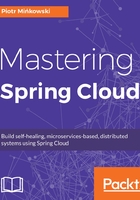
What this book covers
Chapter 1, Introduction to Microservices, will introduce you to the microservices architecture, cloud environment, etc. You will learn the difference between a microservice based application and a monolith application while also learning how to migrate to a microservices application.
Chapter 2, Spring for Microservices, will introduce you Spring Boot framework. You will learn how to effictively use it to create microservice application. We will cover such topics like creating REST API using Spring MVC annotations, providing API documentation using Swagger2, and exposing health checks and metrics using Spring Boot Actuator endpoints.
Chapter 3, Spring Cloud Overview, will provide a short description of the main projects being a part of Spring Cloud. It will focus on describing the main patterns implemented by Spring Cloud and assigning them to the particular projects.
Chapter 4, Service Discovery, will describe a service discovery pattern with Spring Cloud Netflix Eureka. You will learn how to run Eureka server in standalone mode and how to run multiple server instances with peer-to-peer replication. You will also learn how to enable discovery on the client side and register these clients in different zones.
Chapter 5, Distributed Configuration with Spring Cloud Config, will describe how use distributed configuration with Spring Cloud Config in your applications. You will learn how to enable different backend repositories of property sources and push change notifications using Spring Cloud Bus. We will compare discovery first bootstrap and config first bootstrap approaches to illustrate integration between discovery service and configuration server.
Chapter 6, Communication Between Microservices, will describe the most important elements taking a part in an inter-service communication: HTTP clients and load balancers. You will learn how to use Spring RestTemplate, Ribbon, and Feign clients with or without service discovery.
Chapter 7, Advanced Load Balancing and Circuit Breakers, will described more advanced topics related to inter-service communication between microservices. You will learn how to implement different load balancing algorithms with Ribbon client, enabling circuit breaker pattern using Hystrix and using Hystrix dashboard to monitor communication statistics.
Chapter 8, Routing and Filtering with API Gateway, will compare two projects used as an API gateway and proxy for Spring Cloud applications: Spring Cloud Netlix Zuul and Spring Cloud Gateway. You will learn how to integrate them with service discovery and create simple and more advanced routing and filtering rules.
Chapter 9, Distributed Logging and Tracing, will introduce some popular tools for collecting and analizing logging and tracing information generated by microservices. You will learn how to use Spring Cloud Sleuth to append tracing information and correlating messages. We will run sample applications that integrates with Elastic Stack in order to sent there log messages, and Zipkin to collect traces.
Chapter 10, Additional Configuration and Discovery Features, will introduce two popular products used for service discovery and distributed configuration: Consul and ZooKeeper. You will learn how to run these tools locally, and intergrate your Spring Cloud applications with them.
Chapter 11, Message-Driven Microservices, will guide you how to provide asynchronous, message-driven communication between your microservices. You will learn how to integrate RabbitMQ and Apache Kafka message brokers with your Spring Cloud application to enable asynchronous one-to-one and publish/subscribe communication styles.
Chapter 12, Securing an API, will describe varius ways of securing your microservices. We will implement a system consisting of all previously introduced elements, that communicates with each other over SSL. You will also learn how to use OAuth2 and JWT token to authorize requests coming to your API.
Chapter 13, Testing Java Microservices, will describe different strategies of microservices testing. It will focus on showing consumer-driven contract tests, especially useful in microservice-based environment. You will how to use such frameworks like Hoverfly, Pact, Spring Cloud Contract, Gatling for implemnting different types of automated tests.
Chapter 14, Docker Support, will provide a short introduction to Docker. It will focus on describing most commonly used Docker commands, which are used for running and monitoring microservices in containerized environment. You will also learn how to build and run containers using popular continuous integration server - Jenkins, and deploy them on Kubernetes platform.
Chapter 15, Spring Microservices on Cloud Platforms, will introduce two popular cloud platforms that support Java applications: Pivotal Cloud Foundry and Heroku. You will learn how to deploy, start, scale and monitor your applications on these platforms using command-line tools or web console.